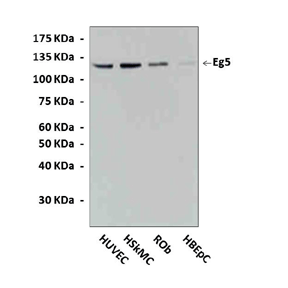Anti-Eg5: Monoclonal Eg5 Antibody |
 |
BACKGROUND Eg5 is a Kinesin-5 (formerly known as BimC) family member of microtubule motor proteins and localizes to spindle microtubules in mitosis but not to interphase microtubules. It has an unusual homotetrameric protein structure that is formed by the anti-parallel arrangement of heavy chains, with pairs of heads situated at opposite ends of a common stalk. In dividing cells, Eg5 is essential for the organization and maintenance of mitotic and meiotic spindles. Organized bipolar spindles contain microtubule arrays emanating from each of two focused poles, with interdigitated, antiparallel microtubules occupying the mid-zone.1 There are at least nine different human kinesins known to be involved in mitosis. The N-terminal Eg5 molecules are responsible for providing a plus-end-directed force associated with sliding microtubules (MTs) during centrosome separation to assemble the bipolar spindle and for prevention of bipolar spindle collapse before anaphase. The Carboxy-terminal motor, human spleen embryonic tissue and testes (HSET), has been proposed to oppose the force developed by Eg5.2 Mitotic kinesin-like protein 1 (MKLP1) is required for mitotic progression. Human KIF4 is associated with chromosomes during mitosis. The kinetochore-associated motor CENP-E is essential for chromosome alignment. The DNA binding protein Kid is involved in chromosome movement during mitosis. Mammalian centromere-associated kinesin (MCAK) is associated with the centromere region during mitosis. M-phase phosphoprotein 1 (MPP1) is required for completion late in cytokinesis. Human RB6K is essential for cytokinesis. Other kinesins may turn out to be involved in mitosis when more of the 40 different kinesins reported in the human genome are investigated in detail.3 Several small-molecule inhibitors of Eg5 have been identified, which specifically and reversibly inhibit Eg5 function leading to monoaster formation and arrested cell division. They are potential therapeutic drugs for cancer treatment.4
REFERENCES
1. Valentine MT et al.: Cell Division 1:31-38, 2006.
2. Wittmann T et al.: Nat Cell Biol 3:E28-E34, 2001.
3. Miki H et al.: Trends Cell Biol. 15: 467-476, 2005.
4. Krzysiak TC et al.: EMBO J. 25: 2263 – 2273, 2006.
2. Wittmann T et al.: Nat Cell Biol 3:E28-E34, 2001.
3. Miki H et al.: Trends Cell Biol. 15: 467-476, 2005.
4. Krzysiak TC et al.: EMBO J. 25: 2263 – 2273, 2006.
Products are for research use only. They are not intended for human, animal, or diagnostic applications.
Параметры
Cat.No.: | CC10014 |
Antigen: | Recombinant His-tagged fusion protein, containing human Eg5 sequence (8-246 aa), expressed in E. Coli. |
Isotype: | Mouse IgG1 |
Species & predicted species cross- reactivity ( ): | Human, Rat, Mouse |
Applications & Suggested starting dilutions: | WB 1:1000 IP 1:50 IHC (Paraffin) 1:100 ICC n/d FACS n/d |
Predicted Molecular Weight of protein: | 130 kDa |
Specificity/Sensitivity: | Detects endogenous levels of Eg5 proteins in normal primary cell lysates. |
Storage: | Store at 4° C for frequent use; at -20° C for at least one year. |
*Optimal working dilutions must be determined by end user.
Документы
Информация представлена исключительно в ознакомительных целях и ни при каких условиях не является публичной офертой








